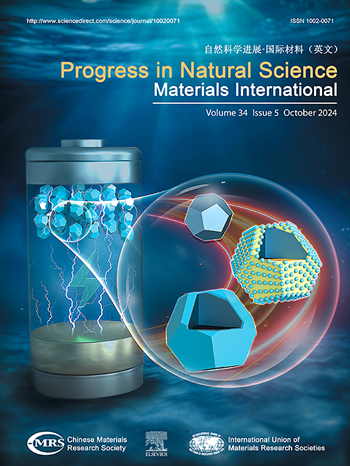活性二维共价有机框架高效、高选择性地光催化还原六价铬
IF 4.8
2区 材料科学
Q2 MATERIALS SCIENCE, MULTIDISCIPLINARY
Progress in Natural Science: Materials International
Pub Date : 2024-10-01
DOI:10.1016/j.pnsc.2024.09.004
引用次数: 0
摘要
本文利用配体三乙醛基甲氧基苯基和苯并[1,2-d:4,5-d]噻唑-2,6-二胺在氨-甲醛缩合反应中成功合成了一种具有噻唑结构和π-π共轭的二维共价有机框架材料(命名为HDU-27),并将其应用于铬(Cr)的光催化还原研究。光催化实验表明,HDU-27 对六价铬具有出色的光催化还原能力,在 pH = 2 的条件下,60 分钟内六价铬的还原效率高达 99.5%。在存在干扰离子的情况下,HDU-27 对六价铬具有极佳的选择性。机理实验和电子自旋共振表征确定了 e- 和 -O2- 自由基是光催化还原 Cr(VI) 的主要活性物种。此外,在 Cr(VI)/有机污染物(RhB、MB、MO)混合体系中,由于有机物的氧化和光生e--h+分离的增加,HDU-27 的光催化速率明显加快。循环实验表明,HDU-27 在光催化还原六价铬方面具有优异的还原稳定性和可回收性。HDU-27 是一种优秀的光催化剂,有望用于去除污染废水中的有机污染物和重金属离子。本文章由计算机程序翻译,如有差异,请以英文原文为准。
Efficient and highly selective photocatalytic reduction of Cr(VI) by an active two-dimensional covalent organic framework
In this paper, a two-dimensional covalent organic framework material (named HDU-27) with thiazole structure and π-π conjugation has been successfully synthesized using the ligands tri acetaldehyde-based methoxyphenyl and benzo [1,2-d:4,5-d]thiazole-2,6-diamine in an ammonia-formaldehyde condensation reaction and applied to the photocatalytic reduction study of chromium (Cr). The photocatalytic experiments showed that HDU-27 had an excellent photocatalytic reduction of Cr(VI) with a high Cr(VI) reduction efficiency of 99.5 % at pH = 2 for 60 min. In the presence of interfering ions, HDU-27 exhibited excellent selectivity for Cr(VI). Mechanistic experiments and electron spin resonance characterization identified e− and ·O2− radicals as the main active species in Cr(VI) photocatalytic reduction. In addition, the photocatalytic rate of HDU-27 was significantly accelerated in the Cr(VI)/organic pollutant (RhB, MB, MO) mixed system due to the oxidation of the organic matter and the increase in the separation of photogenerated e−−h+. The cycling experiments demonstrated the excellent reduction stability and recyclability of HDU-27 in the photocatalytic reduction of Cr(VI). HDU-27 is an excellent photocatalyst with potential application for removing organic pollutants and heavy metal ions from contaminated wastewater.
求助全文
通过发布文献求助,成功后即可免费获取论文全文。
去求助
来源期刊
CiteScore
8.60
自引率
2.10%
发文量
2812
审稿时长
49 days
期刊介绍:
Progress in Natural Science: Materials International provides scientists and engineers throughout the world with a central vehicle for the exchange and dissemination of basic theoretical studies and applied research of advanced materials. The emphasis is placed on original research, both analytical and experimental, which is of permanent interest to engineers and scientists, covering all aspects of new materials and technologies, such as, energy and environmental materials; advanced structural materials; advanced transportation materials, functional and electronic materials; nano-scale and amorphous materials; health and biological materials; materials modeling and simulation; materials characterization; and so on. The latest research achievements and innovative papers in basic theoretical studies and applied research of material science will be carefully selected and promptly reported. Thus, the aim of this Journal is to serve the global materials science and technology community with the latest research findings.
As a service to readers, an international bibliography of recent publications in advanced materials is published bimonthly.

 求助内容:
求助内容: 应助结果提醒方式:
应助结果提醒方式:


